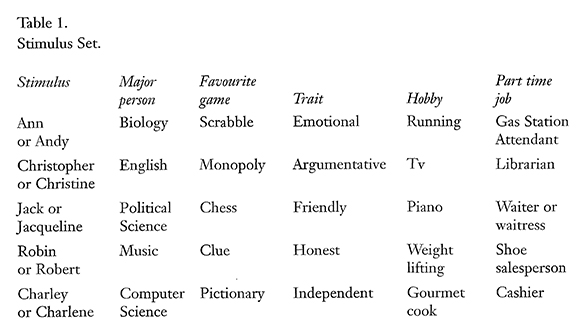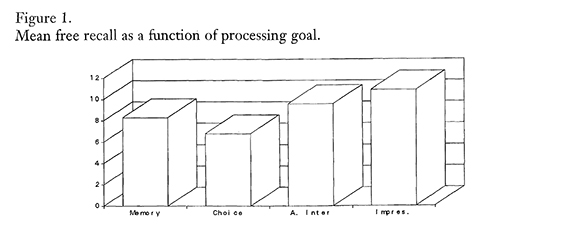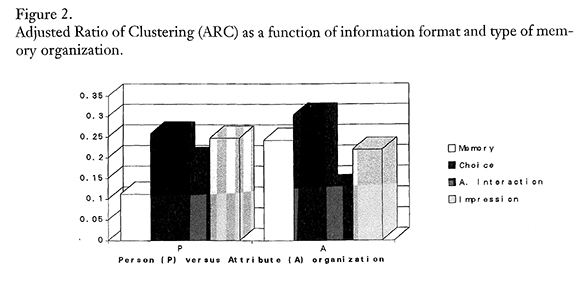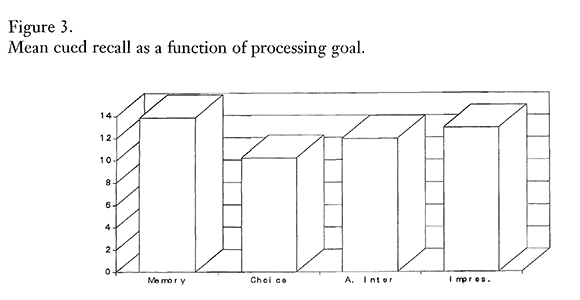Serviços Personalizados
Journal
Artigo
Indicadores
-
 Citado por SciELO
Citado por SciELO -
 Acessos
Acessos
Links relacionados
-
 Similares em
SciELO
Similares em
SciELO
Compartilhar
Psicologia
versão impressa ISSN 0874-2049
Psicologia vol.11 no.1 Lisboa jan. 1996
https://doi.org/10.17575/rpsicol.v11i1.593
The influence of processing goals in a multitarget multidomain context: the quest for memory organisation1
José M. Palma-Oliveira*
*Faculdade de Psicologia e de Ciências da Educação Universidade de Lisboa
ABSTRACT
The person memory field has been witnessing a twofold diversification of research problems. First in what concerns the type and amount of experimental stimuli, and second in the introduction of new processing goals. Extending the experiments of Hamilton and colleagues (Hamilton, Katz & Leirer, 1979, and of Devine and colleagues (Sedidikes, Devine & Furnham, 1991, this research presents subjects with multitarget and multidomain information introducing new motivated encoding strategies and diverse information formats.
Subjects were tested under conditions where they were to either to memorise, to form an impression, to choose one, or to anticipate an interaction with five different targets. The available information about a target concerns several attribute domains (i.e. major, trait, hobby, game and part time ob). The dependent variables were, among others, free and cued recall and ARC organization measures.
The pattern of results is complex. The free recall results replicated the common findings in the literature. Choice processing goal, introduced for the first time in this experiment, showed a free recall level comparable to Memory. This result is in accordance to the use of choice heuristics. The cued recall results showed that Memory subjects had a higher gain that the other processing goals as predicted by the retrieval inhibition phenomena. Organiza tion results were inconclusive.
RESUMO
O estudo da memória de pessoas tem vindo a assistir a uma dupla diversificação dos problemas da pesquisa. Nomeadamente no que concerne ao tipo e à quantidade dos estímulos experimentais e na introdução de novos objectivos de processamento. Estendendo os experimentos de Hamilton e colegas (Hamilton, Katz & Leirer, 1979) e de Devine e colegas (Sedidikes, Devine & Furnham, 1991), a presente investigação apresenta aos sujeitos informação multi-alvo e multidomínio, para além de introduzir novos objectivos de processamento.
Sujeitos foram testados em condições onde tinham de, ou memorizar, formar uma impressão, escolher um, ou antecipar uma interação com cinco diferentes alvos. A informação apresentada sobre os alvos era relativa a diversos domínios (i.e. curso, traço, passatempo, jogo preferido e ocupação). As variáveis dependentes foram, entre outras, evocação livre e com pistas, e medidas de organização da evocação livre.
O padrão de resultados é complexo. Os resultados da evocação livre replicaram os dados mais comuns na literatura. O objectivo de processamento Escolha, introduzido aqui pela primeira vez, mostrou um nível de evocação equivalente ao da condição Memória. Este resultado está de acordo com o uso de heurísticas de escolha. Os resultados da evocação indicada mostraram que os sujeitos da condição Memória mostraram um maior ganho do que os outros objectivos de processamento como o predito. Os resultados das medidas de organização da evocação livre foram inconclusivos.
Introduction.
In an attempt to subsume person impression processes under the social cognitive umbrella, several researchers realised that the analysis of subjects’ recall performance under different processing objectives could provide information about the implicated socio-cognitive processes. Following the seminal work of Hamilton, Katz & Leirer (1981), researchers concluded that the analysis of recall performances, recall organization, and other measures could provide a great amount of information about the procedures people use vhen they process target information.
Recently, the field witnessed a diversification of the research problems with the concomitant enlargement and adaptation of previously existing models. This diversification has been twofold. First, in what concerns the type and amount of experimental stimulus and second, in the diversification of processing goals under study.
The use of more than one target stimulus and other type of information than the behavioral one, can be justified if we realise that in the majority of social contexts one is confronted with information about different persons and about a diversity of attributes or feature categories. More importantly, one must ask if, with a multitarget and multidomain context, we will find results that could be explained with the same models that were successfully applied to the one target, behavioral information experiments.
For instance, with trait related behaviors and one target experiment, the results showed that impression formation processing goal has a higher level of recall and a higher persoffs organisation of recall than memory. These results on the incidental condition originated models where the behavioral information was hypothesised to be connected to traits and the traits to a person node. The question than one might ask is whether this model could be applied when subjects are confronted with information about several person targets and about different domains.
The results obtained thus far showed that this model could not be directly applied and that several factors could intervene. Thus, memory organisation by target person in impression formation conditions should not be considered as granted. Low memory load conditions (Rothbart et al., 1978), information blocked by target (Srull, 1983), and familiarity of the targets Ostrom et al., 1980; Ostrom, Pryor & Sympson, 1981) are factors that favour persoffs information organisation in multitarget contexts.
Sedidikes, Devine and Furnham (1991) have published a work that combines several of the variables above referred. In their Experiment 2 they used, besides anticipated interaction, impression and memory, the self-comparison and friend comparison processing goals. The information was about five different targets and about five descriptors or attributes like major, hometown, etc. The results showed that contact anticipated interaction, impression, self-comparison and friend comparison conditions had a higher level of free recall than the one obtained by the memory condition. Noteworty was that all the processing goaPs conditions did not show any significant differences in recalPs clustering by person and by descriptor. Also no difference was founded between person organisation and desmptor organisation.
These results seem to point to the idea that processing of one target is qualitatively different from the processing of multitarget information.
While in the one targefs studies anticipation interaction and impression conditions showed a higher level of recall that and a higher person clustering (e.g., Devine et al.,1989; Hamilton et al, 1980) in the multi-target studies the later result seems to be absent (Sedidikes et al., 1991).
The present experimental work attempts to contribute to the elucidation of the mental routines implicated in socio-cognitive processing under different Processing goals, not only by using a diversity of dependent measures but also by introducing a novel processing goal. This goal (Choice), besides having a real life «counterpart», is hypothesised to produce free recall and organisational results that, not only would be different from the other incidental ones used (Impression and Anticipated Organisation), but also from Memory.
Design and Method.
This experiment explored the effects of 4 processing goals (memory, impression formation, anticipated interaction and choice) and 3 information formats (information was group by person, attribute or in a random order) on free and cued recall, and on recalPs organisation. The stimulus pertain multiple targets and multiple domains. In this presentation no discussion would be undertaken about the Information Format manipulation.
Subjects either in the memory or the impression conditions received instructions that asked them to memorise or to form impressions of the people about which the information is refereed. The choice and anticipated interaction subjects were led to believe that they would meet the people (the one they have to choose or the líve, respectively) from which the information carne from, and were asked to fill up cards with the same types of category feature information of the stimulus’ people. After they were induced to believe that the stimulus’s information was coming from their colleagues in the other individual experimental booths.
The information that subjects had to scrutinise was presented in a booklet with an item per page (Table 1). After reading the information, and following a filler task, subjects were asked to recall it and to choose the best person (to work with in group task) presented in the booklet. After completing both tasks, subjects were requested to fill up an empty matrix with the stimulus’ people and feature categories’ name (cued recall). Subjects were 120 University of Califórnia Santa Barbara undergraduate students and were run in groups of 6 of the same sex.

Predictions.
Is expected that memory subject organize the incoming items in only episodic memory structure, while impression formation and anticipated interaction subjects would organize, at the encoding process, the information by diverse nodes corresponding to the various targets. The items concerning to a certain stimuli person would be connected by links to the node identified as referent.
The nature of the Choice task appears to be very different from the previous goals. The extent of processing under the choice goal is determined by the choice heuristic used by subjects. Consumer memory researchers (e.i., Biehal & Chakvarty, 1982a) consider that, in choice process, less effort may be directed toward encoding all product information or developing clear associative links with the elimination of brands and informative items. In the present experiment it is expected that heuristics use would determine that subjects in this condition would form an episodic memory structure with a few items.
This encoding and memory organisation diversity implicate different results in the several dependent variables used in this study. For instance, due to the retrieval inhibition phenomenon one could predict that Memory subjects would show a lower level of recall compared with Impression and Anticipated Interaction ones. In these conditons since is expected that targets’ separate memory structures would be formed, one could predict that, when asked to free recall, the Impression subjects would try to find the node corresponding to a given stimuli. From there the subject would try to produce an exhaustive search of the pathways connected with that node before moving to another. If this is the case is expected that the overall number of items remembered in free recall would be superior to the memory condition and that subjects would recall the items in an person’s ordered manner.
Choice would have a lower level of free recall when compared with Impression and Anticipated Interaction conditions and comparable with Memory’s subjects, not due to a retrieval inhibition phenomenon but due to the relatively small quantity of memorised items. These hypotheses consider a difference in memory structure between Memory and Choice subjects not revealed by free recall results.
However, the cued recall task could differentiate between the two conditions. Since the reason for a poorer free recall in Memory is not the absence of memory traces, it is assumed that a cued recall test (where the target name and the feature category are present) will provide an extra amount of retrieval cues that can be used to bolster the number of items accessed. Choice subjects could not profit, in the same extension, of the extra retrieval cues provided by the cue recall test, due to the lack of encoded items or of the proper way to access stored but isolated, and thus not easily accessible, pieces of information.
It is predicted that Memory subjects, in the cued recall task, would improve their performance in a snch a level that no significative differences to Impression and Anticipated Interaction would appear while the Choice condition would have a significative lower level of recall, when compared with the other three conditions.
Results and discussion.
A 4 (Processing goals: Memory, Impression, Choice and Anticipated Interaction) x 3 (Information Format: Person, Attribute and Random) ANOVA was conducted on total recall. Relevant to the predictions was a main effect for Processing Goals, F (3, 99 = 5.260, p < 0.002). It was replicated the difference between Impression and Memory. Choice processing goal, as predicted, attained a level comparable with the Memory condition and significantly above Impression and Anticipated Interaction. Not expected was the equivalence between this last condition (Anticipated Interaction) and Memory (see Figure 1).

Recall organisation was assessed by analysing the extension by which the diverse informative items were recalled in clusters. Since the subjects could organise the information on the basis of person’s (targets) or by attribute’s categories, two indices were computed (ARC’s scores).
The two organisation indices showed no differentiation between themselves. No significative differences between the processing goals conditions in what concerns the recall organisation were founded.
These results replicate the ones obtained by Sedidikes’ et al. (1991) Experiment 2. However, a question that one might ask is if there is a significative difference between the attained degree of organisation and chance level.
Thus, in what concerns the attribute and person organisation, Tests were computed comparing the obtained results with «0». The difference between attribute’s recall organisation (M = 0.237) and that value was significant (p < 0.000). The same could be said of the person organisation (M = 0,181, p < 0.002) (see Figure 2). The results seem to indicate that free recall organisation exists either hy attribute or by person.

The comparison between the processing goals conditions recalPs organisation indices with chance levels sowed the existence of a certain degree ofrecalVs organisation in almost all conditions. That fact relies behind the absence of significative differences between the conditions. While Impression subjects have a certain amount of, both person ‘s and attribute ‘s recai organisation, Memory and Choice subjects seem to show a tendency for one of those organisation formats (Attribute). These results showed that Impression subjects are not particularly prone to have only person’s recall organisation, contrary to predicted. Unexpected was the lack of recalPs organisation showed by Anticipated Interaction subjects. The Choice results, near significant person organisation and significant attribute organisation, also seem coherent with the uses of choice heuristics that induce attribute’s comparison. If one want to compare the above described results with the ones obtained by Sedidikes et al. (1991) Experiment 2, the similarities are remarkable. In Experiment 2 of Sedidikes et al. (1991) Table 2 both descriptor and person organisation attained results very comparable with the ones obtained in the present experiment. Also, as in the present experiment, they were unable of obtaining any recall organisation significative effect between the conditions. Unfortunately they did not furnish the comparisons between the obtained organisation levels and the chance level as was done above.
From these results it could be stated that subjects organise the information both by attribute and by person organisation.
In what concerns the cued recall, results showed that, as predicted, Memory subjects showed superior recall relatively to Choice subjects, t = 3.642, p < 0.005 (one tailed test. Also according to the predictions was the outcome of the comparison of Impression formation and Choice, t = 2.708, p < 0.05 (one tailed test) (see Figure 3). Anticipation Interaction’s results were not significantly different from the other conditions. Thus the predicted recalPs bolstering of Memory subjects was confirmed as the diffficulty of Choice subjects of showing a comparable results’ improvement.

This pattern of results is very important because it could be seen as pointing to the possibility that what seems to cause the low Memory’s free recall level is the retrieval inhibition phenomenon while what lies behind the low Choice’s free recall results are the lack of accessible.
Concluding Remarks.
These results lead to the conclusion that multi-target and multi-domain Processing is somewhat different from one trait-behavioral information Processing. Impression subjects have a higher level of recall and an organisation of recall that is both by person and by descriptor or feature category. One could propose a model where, in the Impression condition and with a multitarget and multidomain context the subjects organise person nodes but also feature category nodes.
Anticipated Interaction results tended to confirm the importance of attention mechanisms in the scrutiny of information. Only in the cases where the attention is focused in a certain amount of information one could expect a higher recall or higher organisation (Devine et al., 1989).
The novel processing goal, Choice, behaved accordingly with the predictions. Particularly interesting is the significative difference between the cued recall levels of choice and memory subjects.
References
Devine, P. G., Sedikides, C., & Fuhrman, R. W. (1989). Goals in social information processing: The case of anticipated interaction. Journal of Personality and Social Psychology, 5, 680-90. [ Links ]
Hamilton, D. L.; Katz, L. B.; & Leirer, V O. (1980a). Cognitive representation of personality impressions: Organizational processes in first impression formation. Journal of Personality and Social Psychology, 391050-63. (1980). Organizational processes in inpression formation. In Hastie, R., Ostrom, T. M., Ebbesen, E. B., Wyer, Jr., R., Hamilton, D. & Carlston, D. E. (Eds.). Person memory: the cognitive hasis of social perception. Hilsdale, New Jersey: Lawrence Erlbaum Associates.
Ostrom, T. M., Lingle, J. H., Pryor, J. B. & Geva, N. (1980). Cognitive organization of person and impressions. In Hastie, R., Ostrom, T. M., Pryor, J. B., Sympson, D. D., (1981). The organization of social information. In E. T. Higgins, C. P. Herman, & Zanna, M. P. (Eds., Social Cogitio: The Ontario Symposium, Vol. 1, pp. 1-38). Hilsdale, New Jersey: Lawrence Erlbaum Associates.
Pryor, J. B., & Ostrom, T. M., (1981). The organization of social information: a converging-operations approach. Journal of Personality and Socil Psycology, 14, 237-55. [ Links ]
Rothbart, M., Fulero, S., Jensen, C., Howard, J. & Birrel, P. (1978). From individual to group impressions: Availability heuristics in stereotype formation. Journal of Experimental Social Psicology, 14, 237-255. [ Links ]
Sedidikes, C., Devine, P. G. & Furnham, R. W. (1991). Social Perception in Multitarget Setting: Effects of Motivated Encoding Strategies. Personality and Social Psycology Bulletin, 17, 625-32 [ Links ]
Srull, T. K. ( 1983). Organizational and retrieval models in person memory: an examination of processing objectives, presentation format, and the possible role of self-generated retrieval cues. Journal of Personality of Social Psycology, 44,1157-70. [ Links ]
Notes
1This experimental work is part of a Phd dissertation currendy in preparation.














